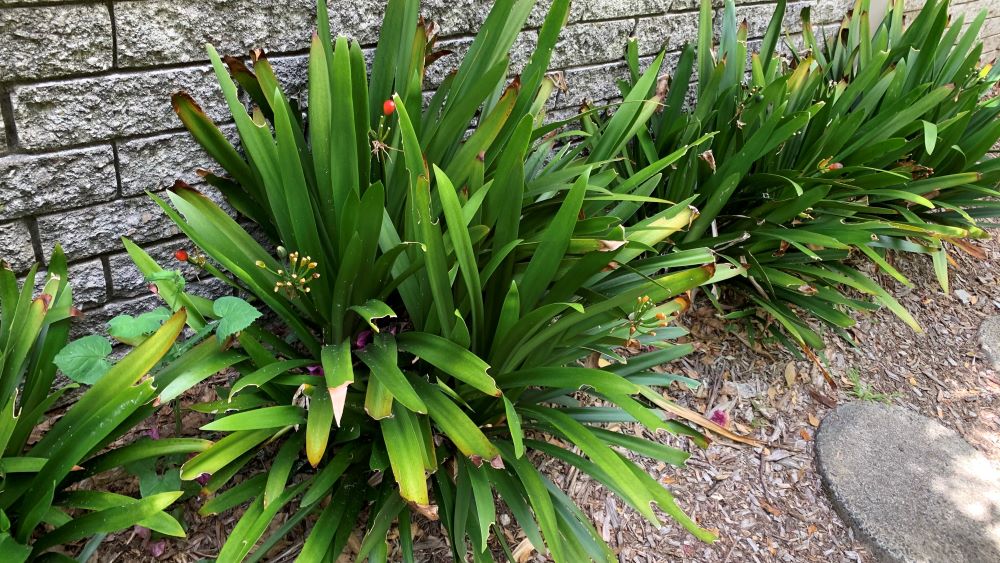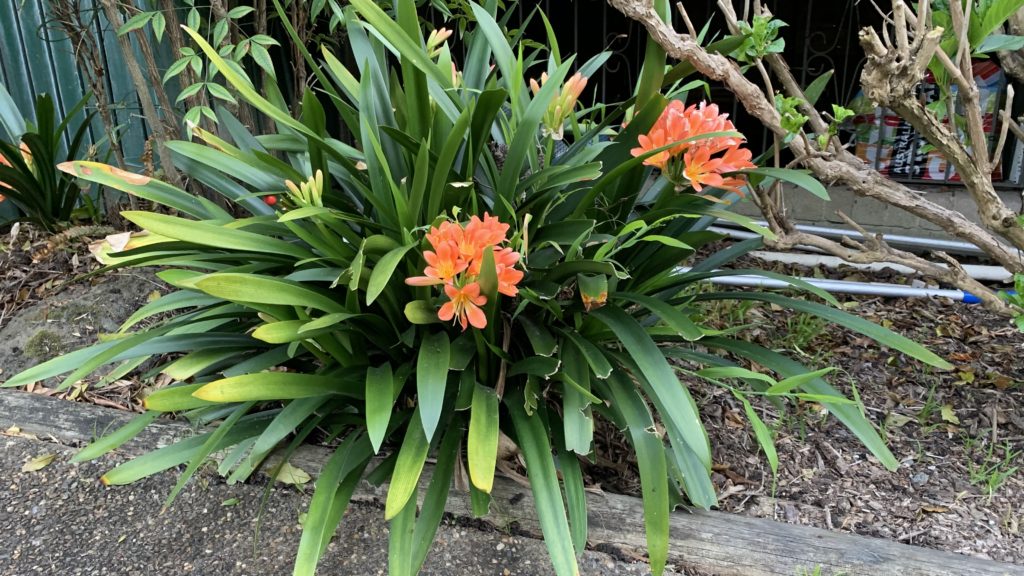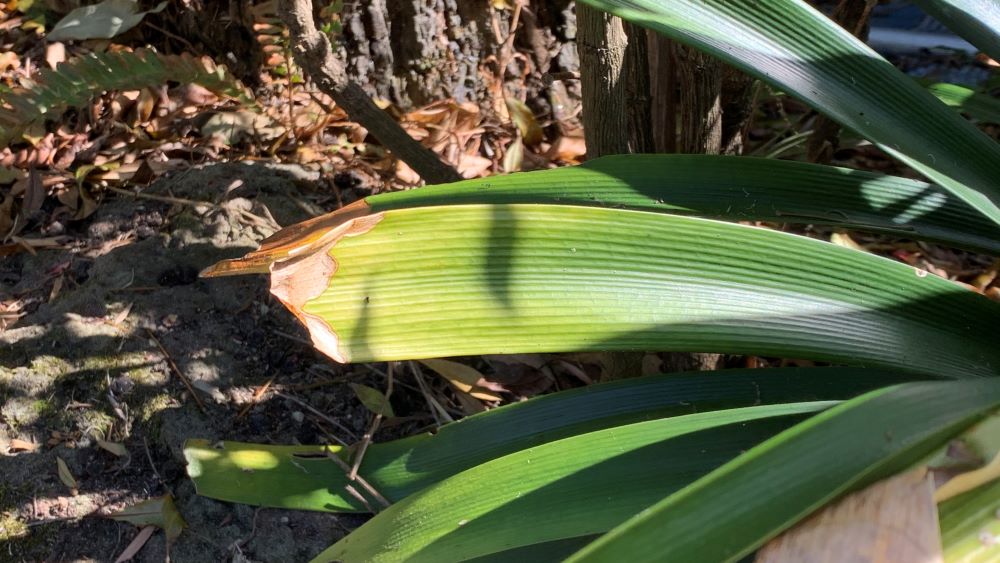Clivia leaves will turn yellow if they are not getting enough nitrogen, if the plant is being overwatered or if it is getting too much sunlight. To help the orange flowering clivia plant to recover and grow new leaves add liquid nitrogen fertilizer, add a small handful of pelleted chicken manure and water it deeply.
You can repeat this again in 2 weeks and your clivia should recover.
Pests can be another cause of yellowing leaves on orange flowering clivia plants. Check the Clivia plant for aphids or spidermite and spray with neem oil.

This article will explore the top 5 causes of yellow leaves on orange flowering clivias and what you can do to fix them.
Why orange flowering clivia leaves turn yellow and solutions
Here are the top reasons why orange flowering clivia leaves turn yellow. Check out each one and see if this might be the cause of the problem for your Clivia.
1. Too much sun
Clivia are shade loving plants and if they get too much sun the leaves can burn and turn yellow. If you have had a tree removed or trimmed and the clivia are suddenly in more sun than usual their leaves can turn yellow.
The solution to this problem is to surround them with plants to provide them with shade during the hottest part of the day. You can also dig them out and move them to a shadier spot. This will give them a better chance of living well in the long term and keeping their dark green leaves.

2. Lack of nitrogen
Orange flowering clivia plants will naturally have deep green leaves but if they lack nitrogen the leaves can turn yellow. The lack of nitrogen can result in a lack of chlorophyll in the leaves which gives them their green color.
Yellow Clivia leaves caused by a lack of nitrogen is easily solved by giving them a feed of diluted liquid nitrogen fertilizer. Repeat this again in 2 weeks. Add a handful of pelleted chicken manure for each plant around the base. Water this in well to give the plant a rapid dose of nitrogen.
The slow release fertilizer will continue to fertilize the clivia plants and help them to get the nitrogen they need. Feed clivia plants in spring to prevent their leaves from turning yellow. When first planting them out it is a good idea to mix through some aged cow manure through the soil to add a range of nutrients.

3. Overwatering
Overwatering is a common reason why Clivia leaves turn yellow. Overwatering can wash away nutrients particularly nitrogen from the roots of the Clivia plant. Nitrogen is easily washed out of the soil and is essential for the green leaf color.
Avoid overwatering Clivia plants by checking the soil moisture before adding more. Clivias grown in shade will have damp soil that longer than plants grown in full sun.
Water clivias deeply if the soil is dry 1-2 inches below the surface
If your clivia plants are growing in pots make sure they can drain well. Don’t leave them sitting in a pot tray full of water as this can cause the roots to rot and the leaves to turn yellow. To avoid this always tip out excess water from the catch tray after watering.
4. Pest attack
Pest attack can be the cause of yellow or damaged leaves on clivia plants. Sap sucking insects such as tiny green aphids or spidermite can cause yellowing marks on the clivia leaves.
Small green aphids can attack clivia plants sucking their sap and causing leaves to turn yellow. These insects will attack any part of the leaf and usually appear in Spring. Ladybugs will naturally move in and eat the aphids.
Clivia plants that are attacked by aphids or spidermite can be treated with Neem oil.

5. Underwatering
Underwatering can cause Clivia leaves to turn yellow if the soil and the plant gets too dry. Clivia plants grown in poor, sandy soils can dry out quickly as the water drains quickly through the soil. When the weather is hot the leaves of the clivia can turn yellow and then brown rapidly.
To avoid this problem start always improve sandy soil by adding compost or aged cow manure. Mix these through well and this will help the soil to hold more water and avoid the leaves turning yellow.
Regularly water clivia plants and apply a 2 inch layer of bark mulch in the warmer months. Keep clivia plants well watered during hot weather can help to prevent leaf yellowing.
What to do when orange flowering clivia leaves turn yellow
Here are the top 3 steps to follow if your orange flowering clivia leaves turn yellow.
1. Check to see if the soil is dry or wet
Stick your finger 1-2 inches below the surface of the soil to check the moisture level. Water the plant deeply if the soil is dry or top the soil with mulch if it is too wet.
2. Liquid feed with nitrogen fertilizer
Add dilute liquid fertilizer to the Clivia plant to fix yellowing leaf problems. Do this in spring and fall each year to help boost plant growth.
3. Trim off yellow and brown leaves
Remove yellow damaged leaves with kitchen scissors or garden secateurs. This will then encourage the plant to grow new stems and new healthy green leaves. Remove old leaves from the outside of the plant and new leaves will grow from the center of the stem.
Orange flowering clivia leaves turning yellow | Summary
Clivia leaves can turn yellow due to too much sun, a lack of nitrogen, over or underwatering or pest attack. Identifying the issue is the first step to fixing the problem and growing dark green and healthy Clivia leaves.
Always set up your Clivia for success by planting them into good quality soil, mixing through compost and aged animal manures and mulch with bark. A healthy plant will be more resistant to pest attack and even damage from the sun.
Happy gardening.
I am an accredited practicing dietitian, experienced gardener and a dedicated cook. I love writing and sharing my experience so you can learn from my successes and mistakes.
